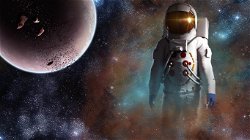The Big Bang Theory: Understanding Origins and Evolution of Universe
James Bond
. 4 min read
The Big Bang theory is the prevailing cosmological model that explains the origin and evolution of the universe. According to the Big Bang theory, the universe was once a singularity, an infinitely hot and dense point in space and time, that began expanding 13.8 billion years ago. As the universe expanded, it cooled and formed into stars, galaxies, and other structures. The Big Bang theory is supported by various pieces of evidence, such as the cosmic microwave background radiation and the redshift of distant galaxies.
.jpg)
The Big Bang Theory: Explaining the Origin and Evolution of the Universe
Both academics and laypeople have been using the phrase "big bang" for close to a century now to talk about the beginning of the universe. This shouldn't come as much of a surprise given that it is the theory of our ancestry that is the most widely accepted. Astronomers try to explain the origin of the universe by referring to something called the "big bang." It is the notion that the universe started out as a single point, then expanded and stretched to become as large as it is right now, and it is continuing to stretch even now.
The Big Bang Conceptualization
Two presumptions form the foundation of the big-bang model. The first is that the gravitational interaction between all matter and space-time is accurately described by Albert Einstein's general theory of relativity. The cosmological principle is the name given to the second assumption, and it asserts that an observer's perspective of the universe is unaffected by either the direction in which he looks or the location at which he stands. This principle only applies to the more extensive aspects of the properties of the universe, but it does imply that the universe does not have a boundary, which means that the origin of the big bang did not take place at a specific location in space but rather simultaneously across the entirety of space.
Evidences of the BIG BANG Theory
Redshift of Galaxies
By the time it reaches us, the light that we observe coming from galaxies has already been stretched. It appears to be a deeper red than it should be. This redshift is caused by the galaxies in the universe moving farther and farther away from us. According to observations, virtually everything in the universe is expanding at an ever-increasing rate. The redshift that is seen in galaxies very far away is evidence that the universe is expanding. If you could turn back the hands of time, you would notice that galaxies are getting closer to one another. If you could travel back in time far enough, everything in the universe would have been in the same location at one point.
The Ambient Microwave Temperature:
The cosmic microwave background (CMB) is radiation that survived the Big Bang, also known as the moment when the universe first came into existence. According to the Big Bang theory, when the universe was first created, it went through a period of rapid inflation, expansion, and cooling. (At this moment in time, the universe is still expanding, but depending on where you look, the expansion rate can appear to be quite different.) The Cosmic Microwave Background (CMB) is a representation of the heat left over from the Big Bang.
A Compilation of Components:
An essential piece of evidence that bolsters the validity of the Big Bang theory is the abundance of light elements throughout the cosmos. It is now common knowledge that the elements that can be found in the universe could have originated from either of two different processes. Elements lighter than helium are thought to have originated in the interiors of stars that formed much later in the history of the Universe. Light elements, such as deuterium, helium, and lithium, were produced in the first few minutes after the Big Bang. Heavier elements are thought to have originated in stars that formed much later. Astronomers have reason to believe this to be true based on both theoretical explanations and empirical evidence.
The Big Bang: An Explosion That Created the Universe
According to what scientists have discovered, at the beginning of the universe, every speck of its energy was compressed into a very small point. This extremely dense point exploded with an inconceivable amount of force, causing the creation of matter and the propulsion of that matter outward to form the billions of galaxies that make up our vast universe. The astronomers and physicists who studied this phenomenon gave it the name "the Big Bang." The Big Bang was an explosion unlike any other that has ever occurred or will ever occur on earth. An explosion caused by a hydrogen bomb, for example, travels through the air at a speed of approximately 300 meters per second, despite having a core that registers approximately 100 million degrees Celsius.
Facts about the Big Bang:
The Big Bang occurred simultaneously in all parts of the universe.
The Big Bang theory suggests that the universe began as a singularity, a point in space and time where the laws of physics break down. At this singularity, all of the matter and energy in the universe were concentrated into an infinitely hot and dense point. This singularity then underwent a massive expansion, causing it to cool and form into the stars, galaxies, and other structures that we see in the universe today. According to the theory, this expansion occurred simultaneously in all parts of the universe, meaning that the Big Bang was not an explosion in the traditional sense.
The Big Bang theory offers an explanation as to the origin of all of the hydrogen and helium found in the universe.
The Big Bang theory suggests that the universe began as a singularity, an infinitely hot and dense point in space and time. The abundance of these two elements in the universe can be explained by the conditions present in the early universe. The high temperatures and densities of the early universe would have favored the production of hydrogen and helium, as these elements are the lightest and least complex of all the atoms.
More Stories from
Best Space Books for Kids and Teens: Educational Books and Fun Stories
This article discusses some of the best space books for kids and teenagers, covering a range of educational and entertaining themes.
The Pros and Cons of Space Colonization: An Overview
An overview of the history and current state of space colonization, including the advantages and consequences.
Exploring the Final Frontier: A Glimpse into the World of Space Research
From probing distant galaxies with space telescopes to charting the potential for human life on other planets, this article provides a glimpse into the evolving field of space research.
Connected Cosmos: Embracing the Future of Space Exploration with Video Chat
Discover the potential for human colonization of other planets, breakthrough propulsion systems, and the expansion of our knowledge of the universe through space-based astronomy.
Chandrayaan-3: India's Ambitious Lunar Mission for Scientific Exploration
Chandrayaan-3, India's third lunar mission led by ISRO, aims to overcome past challenges and demonstrate soft landing capabilities on the Moon.








.png?width=40&aspect_ratio=1:1)


